Arts & Culture
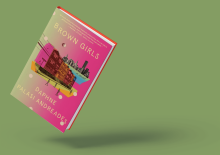
WHISPER NETWORKS. The Greek muses. Immigrant aunties. Women, in groups, are loud and gripping storytellers. Daphne Palasi Andreades’ debut Brown Girls confirms this. In eight immersive sections, the novel chronicles the coming-of-age of the titular brown girls, mainly second-generation immigrants raised in the “dregs of Queens” (N.Y.).With the first-person plural narration, we follow a chorus that aims to reclaim the voices they lost at various junctures in their lives. After all, what demands a shout if not systemic silence?
The brown girls experience erasure early. Their teachers mistake Michaela for Naz, Nadira for Anjali. They snap at Sophie who is Filipino, but call her Mae, who is Chinese. To mold themselves into girls who are worthy of visibility, the brown girls begin to erase themselves. They lighten their skin. They quiet their rage. After middle school, education takes some of them away from Queens. They wrestle with the changes it brings. “Dutifully, we reposition our tongues,” they tell us. “Even in song, we become fluent in the language of our colonizers. Our English, impeccable. Our mother tongues, if we were taught them at all, become atrophied muscles, half-remembered melodies.”

“DO NOT LOOK AWAY. Do not avert your gaze. Do not turn aside.” These words met me a few weeks ago via ecologist Joanna Macy’s ever-relevant book World as Lover, World as Self. I love these words, even though their charge is not an easy one. Looking at what is, without turning away, without aversion, takes incredible strength of will, especially in a culture that banks on our inability to pay attention or handle despair. Nonetheless, for Macy, the illumination of sustainable futures is impossible without first facing our grief. Which brings me, in an extremely roundabout way, to Jane Campion’s film The Power of the Dog and Lorde’s 2021 album Solar Power.
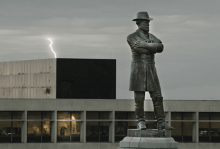
Biased History
Wanting to understand the enduring power of the myth of the Confederate “Lost Cause,” comedian CJ Hunt expanded what was originally a satirical internet video into an insightful documentary. Set against the New Orleans City Council’s 2015 vote to take down four Confederate monuments, The Neutral Ground explores hard truths of our nation’s past. ITVS.

MEILIN LEE, the 13-year-old hero of Pixar’s Turning Red, has a lot on her shoulders. She’s maintaining perfect grades alongside responsibilities helping her mom, Ming (Sandra Oh), run Toronto’s oldest Chinese temple. She’s torn between her identities as a dutiful daughter and a socially active teenager. Oh, and she transforms into a giant red panda in times of strong emotion.
That last issue, it turns out, is genetic. Because of a deal made by an ancestor, the women of Meilin’s family all poof into red pandas when they’re angry, sad, or excited, a trait that emerges during puberty. The panda spirit can be contained through a ritual. Ming is desperate to keep her daughter’s red panda spirit under control. Meilin, however, isn’t sure she wants it subdued.
Directed and co-written by Chinese Canadian animator Domee Shi, Turning Red’s fuzzy transfiguration is a metaphor for real-life stressors.

This week has been one where loss seems as close as it might ever be — losses significantly more important than tennis matches. Thinking of politics as sports is deeply unhealthy but understanding and identifying when we are losing is important. Loss is never inevitable, but neither is victory.
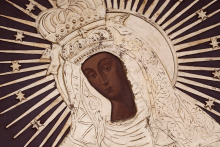
Teresa Kim Pecinovsky's Mother God and Christena Cleveland's God Is a Black Woman offer different portraits of a feminine God whose powerful love reshapes the world.

The show is based on Jon Krakauer’s 2003 book of the same title, detailing the brutal 1984 murder of a woman and her infant baby by two brothers from the Lafferty clan, a prominent family in the Church of Jesus Christ of Latter-day Saints.
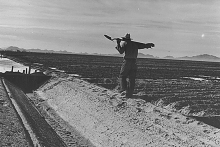
Through the years, we’ve written about the ways churches can help workers — and the way workers can help the church.

The Bad Guys asks viewers to check their biases and assumptions about who is “good” and who is “bad.”
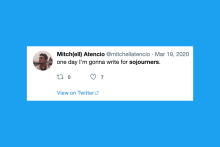
Twitter is a strange thing — if it’s any singular thing at all. If it does come to an end, I hope we’ll look back reflectively and carefully, learning from what we got right, what we got wrong, and growing into the future.

Jesus rose on Sunday, but my heart is stuck in Lent.
Last week my church gathered our first in-person Holy Week services since before the pandemic. We sung Charles Wesley’s classic Easter hymn, “Christ the Lord Is Risen Today,” our trailing alleluias slightly out-of-sync as we remembered how to blend our voices. But when we got to the line, “Where, O death, is now thy sting?” the words stuck in my throat. Love’s redeeming work is done — I do believe that — but fresh examples of death’s sting aren’t hard to spot.

While Rethinking Sex maintains a nearly secular perspective throughout, toward the end of the book she draws on 13th-century theologian Thomas Aquinas’ definition of love, which is that we should be “willing the good of the other” and creating goodwill in our relationships and interactions with other people.

On the IRS Form 1040, there is a section titled “Third Party Designee” which asks, “Do you want to allow another person to discuss this return with the IRS?” When filling out my 1040 for 2021, I simply wrote, “Jesus paid it all, all to him I owe.” This is what people mean when they say, “let go and let God,” right?
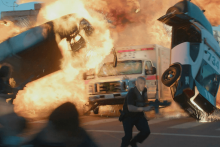
Copaganda refers to any piece of media that portrays police as a necessary social institution. While this can include viral videos of police chatting with neighborhood kids or doing lip-sync battles, the most pervasive examples of copaganda are found in pop culture.
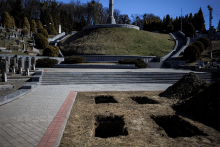
Proximity and humility are sometimes an answer for our beliefs.
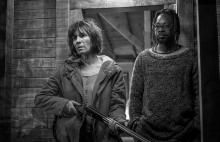
The Bulgarian town where director Ivaylo Hristov’s latest film takes place is never named, but the movie’s title offers a suitable stand-in: Fear. This coastal village on Turkey’s border reeks of terror, but not the kind one might expect.
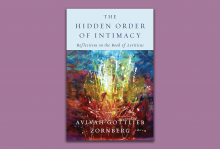
Reprinted by permission of Schocken Books, an imprint of the Knopf Doubleday Publishing Group, a division of Penguin Random House LLC. Copyright © 2022 by Avivah Gottlieb Zornberg. Purchase the book at penguinrandomhouse.com.
IMMEDIATELY AFTER THE first commandment (“I am the Lord your God who has brought you out of the land of Egypt, from the house of slaves”) comes the second commandment—almost as though after a colon: “You shall have no other gods in My presence.” The Exodus represents a break for freedom, and the construction of a new identity based on that freedom. An important aspect of freedom is the separation not just from Egypt but from the fascination with Egypt’s gods. The Exodus is an iconoclastic project; entering a covenant with the One God is an attempt to break the idolatrous spell.
Eric Santner offers a psychoanalytic understanding of what he calls Egyptomania.

Date: Sunday, May 17, 2122
To: allchurch @gracechurch.metaverse
From: staff @gracechurch.metaverse
Subject: Children singing in church
RECENTLY OUR STAFF has received many questions about why we do not permit children to sing during services. We understand that this is a contentious issue, and we want to do our best to respond to these concerns. Before we begin, it must be made clear that on all matters of doctrine, we look to the sacred All-Church PDF sent out by our founding elders in the year 2022, almost 100 years ago, which clearly defined our church policy.
To begin, let us look at section 4.A of the holy PDF. It states: “Please do not allow your children to sing during the sermon, especially if it’s a shouted rendition of ‘We Don’t Talk About Bruno.’” Given this language from the foundational All-Church PDF, the prescribed ban on singing seems clear (although we’re not quite sure who Bruno was or why people weren’t supposed to talk about him). Some of you have noted that this directive may have been a response to disruptions during services. While it is true that we have found several cellphone videos from 2022 of children standing up to loudly sing in the middle of the Eucharist, there is simply no way to know if section 4.A of the PDF was written in response to that.
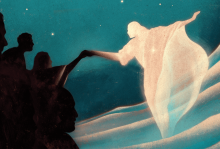
Touch me and see, because a ghost does not
have flesh and bones as you can see I have.
—Luke 24:39
So easily startled by vastness, dark
distances, arrival, they were terrified by him
that night glimmering in their midst.
Jesus knew they needed to finger the familiar
relief of bones under warm flesh to believe
the body, pale star
studding their peripheral vision, a specter
rattling even Peter, who had seen the not-
ghost of him before, walking the sea. Jesus
knew their need to know he hungered, tasted
the tilapia baked in olive oil with salt, lemon,
tangy fingers to mouth.
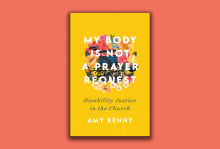
SOME CHURCHES HAVE fought to be exempted from the Americans with Disabilities Act, have interpreted scripture in ways that cause violence against disabled people, and are often rife with ableist microaggressions unique to religious communities. Amy Kenny’s My Body Is Not a Prayer Request—part memoir and part disability justice hermeneutic—is a book the church desperately needs.
Kenny encounters strangers, many of them Christians, who comment on her body. They describe their ableist version of heaven, pray over her without consent (she refers to these people as “prayerful perpetrators”), ask for personal medical information, and give pitying glances. “I wish I was whole in their minds,” writes Kenny, “enough to exist without needing a prayerful remedy to cast out my ‘demons,’ a full human who has something to offer other than a miraculous narrative.”